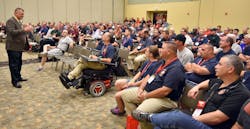FHExpo: Salka Uses LODD Case study to Address Fireground Responsibility
“Across the country, we have all come to learn that the high level of firefighter death and injuries is unacceptable.” This was one of the first points made by FDNY Battalion Chief John Salka during his Friday morning session “Fireground Responsibility” at Firehouse Expo in Baltimore. The session explored the contributing factors from an FDNY line-of-duty death and then asked participants to consider who was ultimately responsible for the each factor.
Salka selected a NIOSH LODD report involving FDNY Firefighter Thomas Brick, who died during search operations at a commercial structure fire in upper Manhattan in December 2003. Salka identified four groups that may hold some level of responsibility at any fire: the firefighter(s) involved, the chief in command, the company officer and the other firefighters operating on scene. He then offered eight operational factors that contributed to the incident, and asked class members to consider who holds the responsibility for each:
- Unoccupied warehouse fire
- Operated remote from the crew
- Members heard a scream
- Missing firefighter mistakenly “found”
- Victim had a working radio
- SCBA facepiece was off
- PASS alarm not audible
- Carboxyhemoglobin = 74%
Unoccupied warehouse fire
Salka explained how the fire’s location in an unoccupied warehouse fire impacted the event. For events like this, he said, the fire attack should be slow, cautious and deliberate. Additionally, the crew did not use a search rope—a must for this type of operation in that type of building. Salka reminded the class that the company officer is ultimately responsible for accountability during these types of operations. “The company officer keeps track of their firefighters,” he said. “They are morally and legally responsible for everyone.”
Operated remove from the crew
Salka explained that during the search operations, the team of three split into two groups for expedited searching —Firefighter Brick headed down one hallway, and the company officer and a probationary firefighter headed down another hallway. The key problem: Brick failed to stay in communication with the officer, and the officer did not stay in communication with Brick. Salka reminded of the importance of staying in constant communication, even if things are OK and the contact is simple a tactical update to report no change in conditions.” “If you give a tactical transmission, the accountability comes with it,” he said. With this situation, Salka said the responsibility ultimately falls on the company officer to check in with his crewmember, particularly if they are operating alone. “Should Tommy have called him? Absolutely. But the officer is ultimately responsible.”
Members heard a scream
At some point during the incident, some of the other firefighters operating on the scene thought they heard what sounded like a scream. They even reportedly shouted back, saying “Tommy, is that you?” The problem: “They said nothing,” Salka said. For this particular factor, Salka said the responsibility fell to the other operating firefighters operating on scene.
Missing firefighter reportedly “found”
After realizing that Firefighter Brick was not responding to radio communication, a mayday was transmitted. And as heavy fire conditions drove companies from the fire area, the company officer thought he located Brick exiting the building. The company officer canceled the mayday, which Salka said was not the correct course of action. He then reminded the class of the importance of a mayday and how no one should feel ashamed to call one. “There is no such thing as an unnecessary mayday,” he said. The problem: Once crews were outside, it was determined that the “located” firefighter was not Brick; he was still missing. For this factor, Salka said that while the company officer should not have canceled the mayday, it is ultimately the incident commander’s responsibility to manage this situation.
Victim had a working radio
Salka went through the facts: Brick was radio-equipped; no emergency messages were received; there was no response to the radio calls for a missing firefighter; and the radio was working after Brick was located. Salka acknowledged that it is impossible to know exactly what happened to Brick and why he did not use his radio to call for help. He speculated that he could have been embarrassed about the situation or tried to solve the problem on his own before being overcome. He added that research shows that hearing is compromised in high-anxiety situations, so perhaps Brick could not hear his officer’s radio messages. In the end, Salka said, based on the available information and what likely occurred, the responsibility comes back to Brick for not using his radio to call for help.
SCBA facepiece was off
Salka said when Brick was located, it appeared that he had removed his facepiece, although it is impossible to know for certain. His facepiece button was clicked “off,” meaning he did not run out of air. Further, there was 900 psi of air left in the cylinder. Salka urged everyone to know how much air they would have with specific amounts of air in a cylinder. “If you don’t do air consumption drills now, start doing them,” he said. He added that firefighters should never remove their facepieces in IDLH environments, explaining that this created additional operational problems. Here, the responsibility falls to Brick.
PASS alarm not audible
Salka explained that the PASS alarm was on and SCBA was integrated; it was activated and sounding; and it was not audible until Brick’s body was turned over.
Carboxyhemoglobin = 74%
Salka reminded the class that Brick did not run out of air. Instead, he died of carbon monoxide (CO) poisoning. He said it is possible that Brick could have inhaled CO if he removed the facepiece to call for help—possibly the scream the other firefighters heard.
In sum
Salka underscored that each operational factor is a link in the chain of events, and if any one link is broken, things would have been very different: “Fix one and the chain is broken. He lives.”

Janelle Foskett
Janelle Foskett served as editorial director of Firehouse Magazine and Firehouse.com, overseeing the editorial operations for the print edition along with working closely with the Web team.






